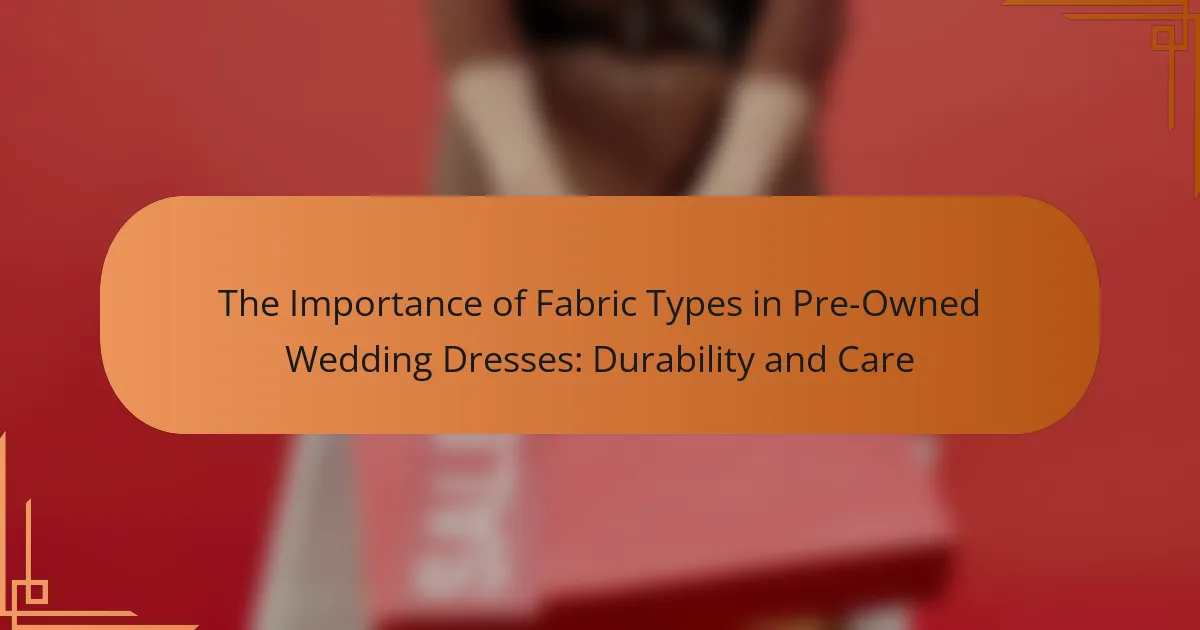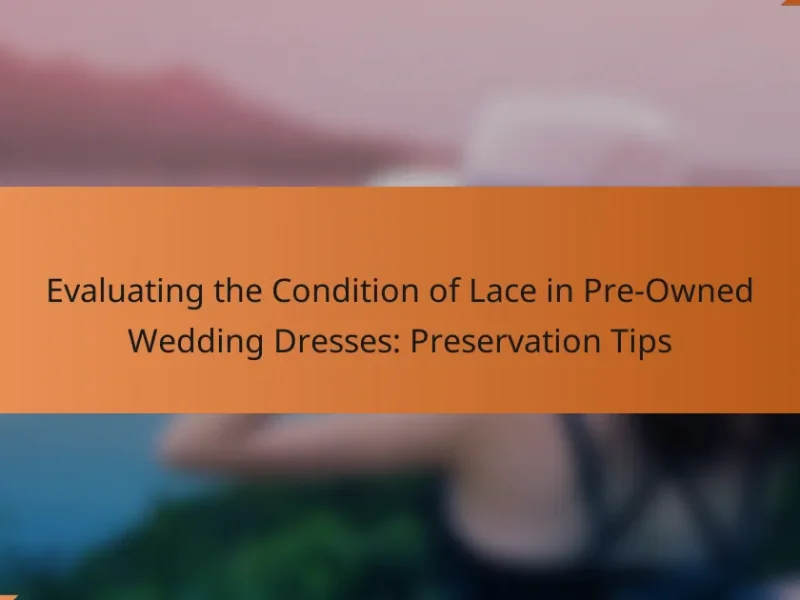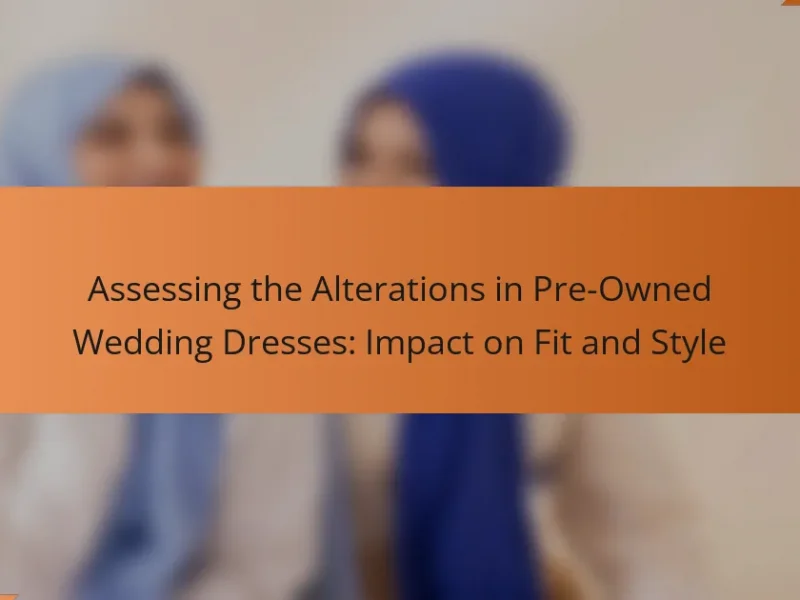Fabric types in pre-owned wedding dresses play a crucial role in determining their durability, appearance, and maintenance needs. Each fabric, such as silk, polyester, satin, lace, tulle, and chiffon, has unique characteristics that affect the dress’s longevity and aesthetic. Understanding these differences helps buyers make informed decisions regarding care and preservation, ensuring that the dress remains beautiful for future use or resale. Proper care techniques tailored to each fabric type are essential for maintaining the dress’s quality and extending its lifespan. This article examines the significance of fabric selection and care strategies for pre-owned wedding dresses.
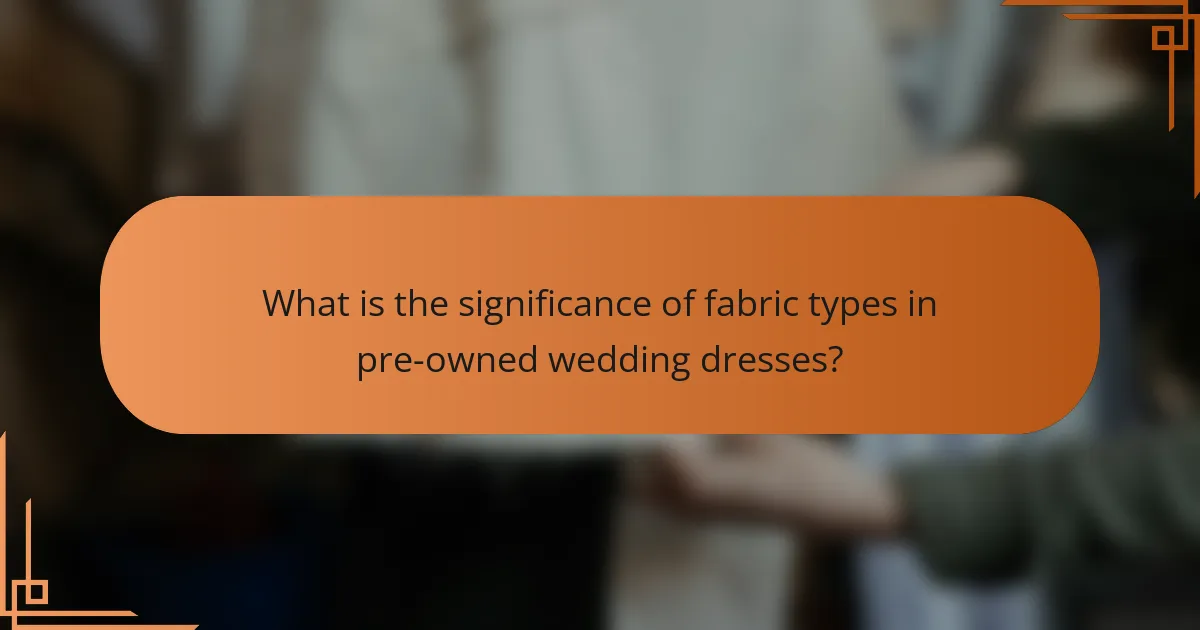
What is the significance of fabric types in pre-owned wedding dresses?
Fabric types in pre-owned wedding dresses significantly affect their durability and overall appearance. Different fabrics have varying levels of resilience and maintenance requirements. For example, silk is luxurious but can be delicate and prone to staining. Conversely, polyester is more durable and resistant to wrinkles. The choice of fabric impacts how well the dress retains its shape over time. Additionally, certain fabrics may require specific cleaning methods to preserve their quality. Understanding fabric types helps buyers make informed decisions about care and longevity. This knowledge ensures the dress remains beautiful for future wear or resale.
How do different fabric types impact the durability of pre-owned wedding dresses?
Different fabric types significantly impact the durability of pre-owned wedding dresses. Fabrics like silk and chiffon are more delicate and susceptible to wear and tear. In contrast, polyester and satin offer greater resilience and longevity. The weave and density of the fabric also play a crucial role in durability. For instance, tightly woven fabrics resist fraying better than loosely woven ones. Additionally, certain fabrics may yellow or degrade over time due to exposure to light and moisture. Understanding these characteristics helps in selecting pre-owned dresses that maintain their integrity.
What are the most common fabric types used in wedding dresses?
The most common fabric types used in wedding dresses include satin, lace, chiffon, tulle, and organza. Satin is popular for its smooth finish and luxurious feel. Lace adds intricate detailing and a romantic touch. Chiffon is lightweight and flows beautifully, making it ideal for soft silhouettes. Tulle is often used for skirts and veils due to its airy quality. Organza is a crisp fabric that provides structure while remaining lightweight. These fabrics are frequently chosen for their aesthetic appeal and versatility in design.
How does fabric weight influence the longevity of a wedding dress?
Fabric weight significantly influences the longevity of a wedding dress. Heavier fabrics tend to be more durable and resistant to wear and tear. For example, fabrics like satin and taffeta are often heavier and can withstand stress better than lighter materials. Lighter fabrics, such as chiffon or organza, may be more delicate and prone to damage over time. The weight of the fabric also affects how well it holds up to cleaning and storage. Heavier fabrics usually retain their shape and structure longer, while lighter fabrics may require more careful handling. Studies indicate that fabric weight correlates with durability, impacting the overall lifespan of the dress.
Why is fabric care important for pre-owned wedding dresses?
Fabric care is important for pre-owned wedding dresses to maintain their condition and appearance. Proper care prevents deterioration of delicate materials. Many wedding dresses are made from fabrics like silk, lace, and tulle, which can be sensitive to stains and environmental factors. Regular cleaning and preservation can extend the life of these garments. For instance, ignoring stains can lead to permanent discoloration. Additionally, proper storage helps to prevent creasing and fabric weakening. According to the Wedding Dress Preservation Company, untreated dresses can lose their vibrancy over time. Therefore, diligent fabric care is essential for preserving the beauty and integrity of pre-owned wedding dresses.
What specific care methods are recommended for different fabric types?
Cotton requires machine washing in cold water and can be tumble dried on low heat. Silk should be hand washed or dry cleaned, avoiding direct sunlight to prevent fading. Polyester is durable and can be washed in warm water; it resists wrinkles and can be tumble dried. Lace needs gentle hand washing and should be air dried flat to maintain its shape. Velvet should be dry cleaned to preserve its texture and sheen. Wool requires hand washing in cold water or dry cleaning to prevent shrinking. Each fabric type has specific care methods to ensure longevity and maintain appearance.
How can improper care affect the appearance and lifespan of a wedding dress?
Improper care can significantly diminish the appearance and lifespan of a wedding dress. Neglecting to clean a dress after use can lead to permanent stains and discoloration. For example, sweat, makeup, and food residues can cause fabric deterioration over time. Storing a dress in a humid environment can promote mold growth, which damages the fabric. Additionally, using harsh chemicals during cleaning can weaken fibers and alter colors. Improper folding can also lead to creases and fabric distortion. Overall, these factors can result in a dress losing its original beauty and structural integrity.
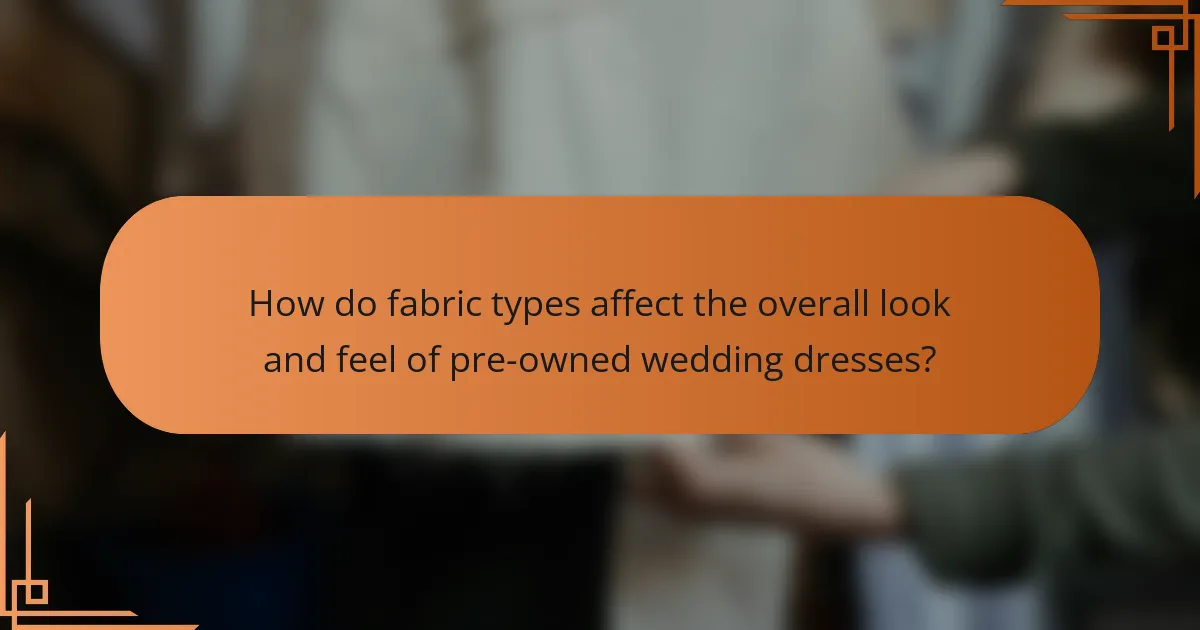
How do fabric types affect the overall look and feel of pre-owned wedding dresses?
Fabric types significantly influence the overall look and feel of pre-owned wedding dresses. Different fabrics create distinct silhouettes and textures. For example, satin offers a smooth and luxurious appearance. Lace adds a romantic and delicate touch. Tulle provides a light and airy feel, enhancing volume. Additionally, fabrics like chiffon drape elegantly, resulting in soft movement. The choice of fabric also affects comfort and breathability. Heavier fabrics may feel more structured, while lighter options allow for ease of movement. Overall, the fabric type directly impacts the aesthetic and tactile experience of wearing a pre-owned wedding dress.
What role does fabric texture play in the aesthetic appeal of wedding dresses?
Fabric texture significantly influences the aesthetic appeal of wedding dresses. Different textures can evoke various emotions and styles. For instance, lace adds a romantic and vintage feel. Satin provides a smooth and luxurious appearance. Tulle creates a light and ethereal look. The interplay of textures can enhance visual interest. Textured fabrics can also affect how light interacts with the dress. This interaction can create depth and dimension. Ultimately, the choice of fabric texture contributes to the overall design and theme of the wedding.
How does the choice of fabric influence the drape and silhouette of a dress?
The choice of fabric significantly influences the drape and silhouette of a dress. Different fabrics have unique weights, textures, and stiffness. For example, silk has a natural sheen and fluidity, creating a soft drape. This allows it to contour to the body’s shape, enhancing the silhouette. In contrast, fabrics like taffeta are stiffer and hold their shape, resulting in a more structured silhouette. Heavier fabrics, such as velvet, provide a dramatic effect but may limit movement. Lighter fabrics, like chiffon, create a flowing appearance, ideal for ethereal styles. The fabric’s composition also affects how it interacts with body movements, impacting the overall aesthetic. Therefore, selecting the right fabric is crucial for achieving the desired look and feel of a dress.
What fabrics are best for achieving a vintage look in pre-owned wedding dresses?
Silk, lace, tulle, and satin are the best fabrics for achieving a vintage look in pre-owned wedding dresses. Silk provides a luxurious sheen and drapes beautifully, reminiscent of classic styles. Lace adds intricate detailing, often associated with vintage aesthetics. Tulle offers a light and airy feel, perfect for creating a whimsical silhouette. Satin has a smooth finish, often used in traditional designs. These fabrics have been historically favored in wedding dresses, enhancing their timeless appeal.
How can fabric types correlate with seasonal wedding trends?
Fabric types correlate with seasonal wedding trends by influencing the aesthetic and functionality of wedding attire. For example, lightweight fabrics like chiffon and lace are popular in spring and summer weddings due to their breathability. In contrast, heavier materials such as satin and velvet are favored in fall and winter for their warmth and elegance.
Seasonal colors also impact fabric choices. Pastel shades in lighter fabrics align with spring themes, while rich jewel tones in heavier fabrics suit autumn celebrations. Additionally, the texture of fabrics can enhance the overall wedding theme, with soft, flowing materials complementing outdoor settings and structured fabrics fitting formal venues.
Statistical data from wedding industry reports indicate that fabric choice significantly affects bridal gown sales during different seasons. For instance, a survey by The Knot revealed that 70% of brides consider fabric when selecting their dress, highlighting its importance in aligning with seasonal trends.
Which fabrics are suitable for summer weddings versus winter weddings?
Lightweight fabrics are suitable for summer weddings, while heavier fabrics are ideal for winter weddings. Summer weddings benefit from breathable materials like chiffon, linen, and cotton. These fabrics allow air circulation and keep the bride cool. In contrast, winter weddings require insulating fabrics such as satin, velvet, and brocade. These materials provide warmth and a luxurious feel. The choice of fabric impacts comfort and style significantly. Selecting the right fabric enhances the overall wedding experience for the couple and guests.
How do fabric types affect the comfort level of wearing a wedding dress?
Fabric types significantly affect the comfort level of wearing a wedding dress. Different fabrics have unique properties that influence breathability, weight, and texture. For instance, lightweight fabrics like chiffon and organza allow for better airflow, enhancing comfort in warm settings. In contrast, heavier fabrics such as satin or taffeta may cause discomfort due to their weight and reduced breathability.
Additionally, the texture of the fabric impacts how it feels against the skin. Silks and soft cottons provide a gentle touch, while stiffer materials can irritate sensitive skin. The stretchability of fabrics also plays a role; materials with some elasticity, like jersey, can offer more freedom of movement.
Moreover, the lining of the dress, often made from softer materials, contributes to overall comfort by reducing friction between the skin and the outer fabric. Ultimately, choosing the right fabric type is crucial for maximizing comfort on a wedding day.
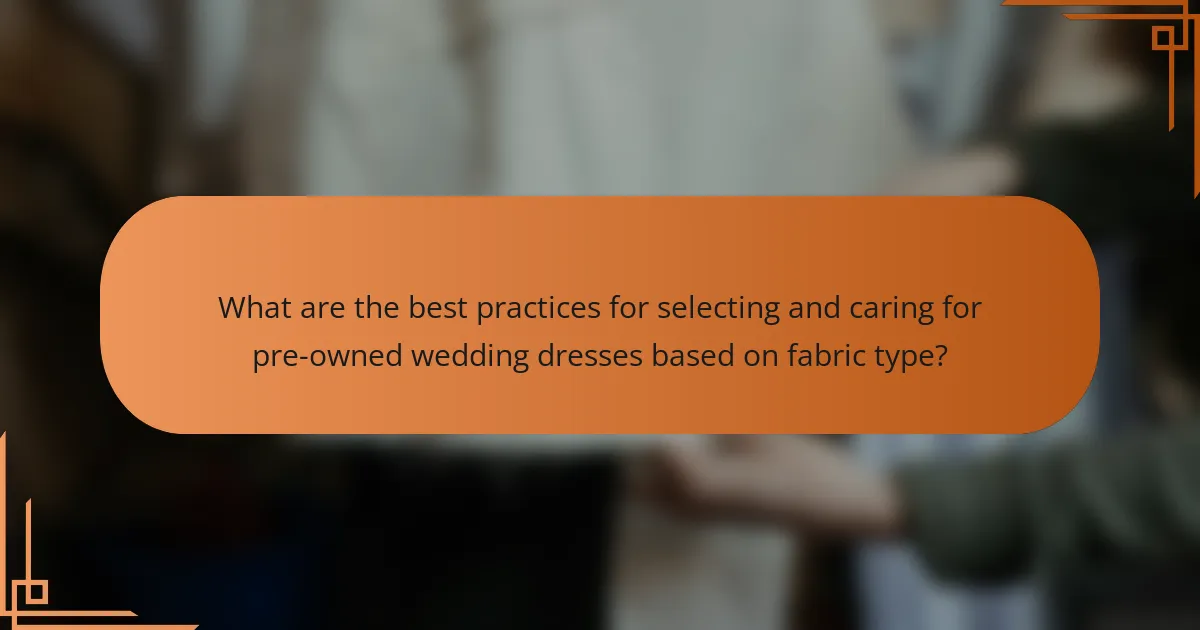
What are the best practices for selecting and caring for pre-owned wedding dresses based on fabric type?
Selecting and caring for pre-owned wedding dresses requires attention to fabric type. Different fabrics have unique characteristics that affect their durability and maintenance. For silk dresses, inspect for stains and ensure they are professionally cleaned to prevent damage. Satin requires gentle handling; avoid exposure to direct sunlight to prevent fading. Lace should be carefully examined for tears and should be stored flat to maintain its shape. Tulle can snag easily, so keep it away from rough surfaces. For polyester, regular washing is acceptable, but avoid high heat when drying. Always check care labels for specific instructions related to each fabric type. Proper care extends the life of the dress and preserves its beauty.
How can buyers assess the fabric quality of pre-owned wedding dresses?
Buyers can assess the fabric quality of pre-owned wedding dresses by examining the material closely. They should check for any signs of wear, such as fraying or discoloration. A tactile evaluation is essential; feeling the fabric can reveal its softness and durability. Buyers should also look for labels that indicate the fabric type, such as silk, satin, or lace. Understanding the characteristics of different fabrics aids in this assessment. For example, silk is known for its luxurious feel and sheen, while polyester is more durable and less prone to wrinkling. Additionally, inspecting the stitching quality can indicate the overall craftsmanship of the dress. High-quality stitching typically signifies better fabric integrity. Lastly, buyers should inquire about the dress’s history, including any cleaning or repairs, which can affect fabric quality.
What signs indicate good fabric quality in a pre-owned dress?
Good fabric quality in a pre-owned dress can be indicated by several signs. First, examine the fabric for a smooth texture. High-quality fabrics often feel soft and luxurious to the touch. Second, check for consistent color and pattern. Good quality fabrics maintain their dye evenly without fading. Third, inspect the stitching. Neat, tight stitches suggest durability and craftsmanship. Fourth, look for natural fibers like silk or cotton. These materials typically offer better breathability and longevity. Lastly, assess the weight of the fabric. Heavier fabrics often indicate better quality due to their ability to hold shape and resist wear.
How can buyers determine the right fabric type for their wedding theme?
Buyers can determine the right fabric type for their wedding theme by considering the theme’s aesthetic and climate. Different fabrics convey different moods; for instance, silk offers elegance, while lace adds a romantic touch. Buyers should also evaluate the season; heavier fabrics suit winter weddings, while lighter materials are ideal for summer. Additionally, the level of formality influences fabric choice; satin is often used for formal events, while cotton is more casual. Understanding the care requirements of each fabric is crucial as well, especially for pre-owned dresses. For example, silk may require dry cleaning, while polyester can often be machine washed. By aligning fabric choices with these factors, buyers can ensure their wedding attire complements their overall theme effectively.
What tips are essential for maintaining the beauty of pre-owned wedding dresses?
To maintain the beauty of pre-owned wedding dresses, proper care is essential. Start by storing the dress in a cool, dry place away from direct sunlight. Use a breathable garment bag to protect it from dust and moisture. Regularly inspect the dress for any signs of wear or damage. Clean the dress according to the fabric type, following care labels closely. Professional cleaning is recommended for delicate fabrics like silk or lace. Avoid hanging the dress on a hanger for long periods to prevent stretching. Lastly, handle the dress with clean hands to prevent stains. These practices help preserve the dress’s appearance and longevity.
How often should pre-owned wedding dresses be cleaned based on fabric type?
Pre-owned wedding dresses should be cleaned based on their fabric type. Delicate fabrics like silk and satin require cleaning after every use. Heavier fabrics such as taffeta and organza can be cleaned every 3 to 5 wears. Lace should be cleaned after each use due to its intricate nature. Synthetic fabrics like polyester may only need cleaning once every 5 to 10 wears. Regular cleaning helps maintain the dress’s appearance and longevity. Proper care prevents stains and fabric degradation over time.
What storage methods are best for preserving different fabric types in wedding dresses?
Acid-free preservation methods are best for storing wedding dresses made from delicate fabrics. For silk, store in a breathable cotton bag to prevent yellowing. For lace, flat folding is ideal to avoid creasing. For taffeta, use acid-free tissue paper to support the fabric’s structure. For satin, hanging with padded hangers can help maintain shape. Avoid plastic covers as they trap moisture and promote mildew. Store in a cool, dry place away from direct sunlight to prevent fading. These methods help maintain the integrity and appearance of various fabric types over time.
The main entity of this article is pre-owned wedding dresses, with a focus on the significance of fabric types in relation to their durability and care. The article outlines how different fabrics, such as silk, polyester, and lace, impact the longevity, appearance, and maintenance requirements of wedding dresses. It discusses the importance of selecting appropriate fabrics based on seasonal trends and wedding themes, as well as best practices for cleaning and storing these garments to preserve their quality. Additionally, the article provides insights into assessing fabric quality and offers tips for maintaining the beauty of pre-owned dresses.
